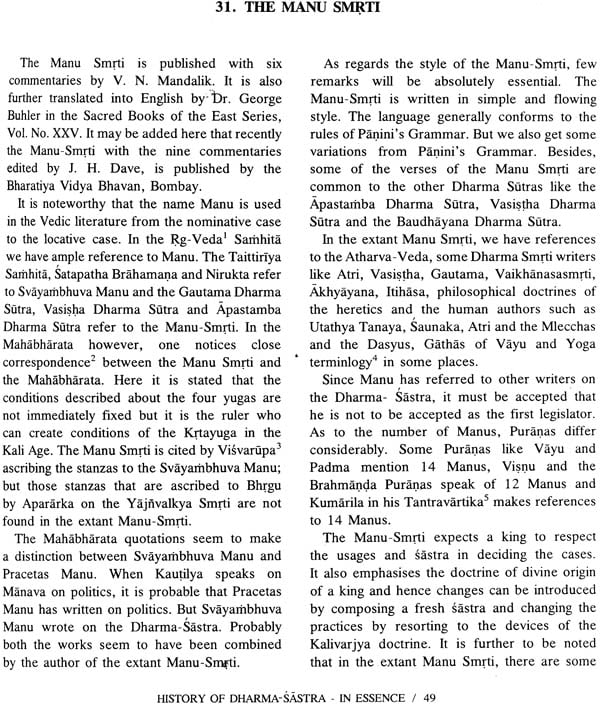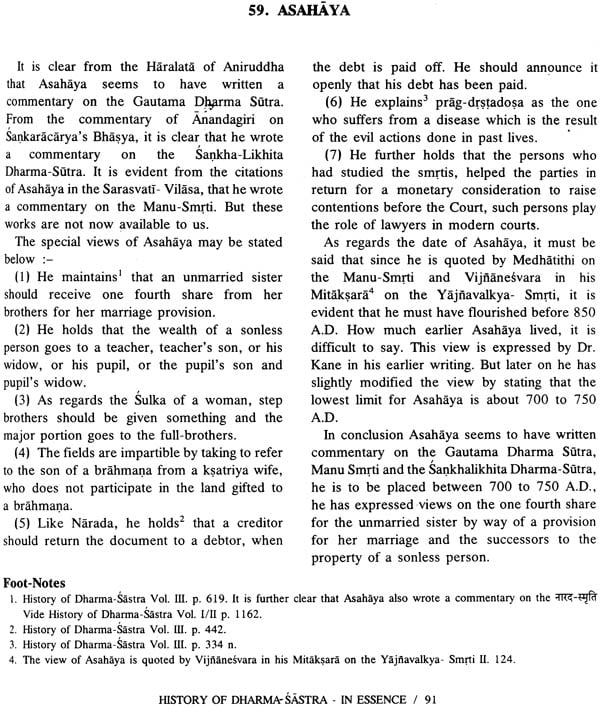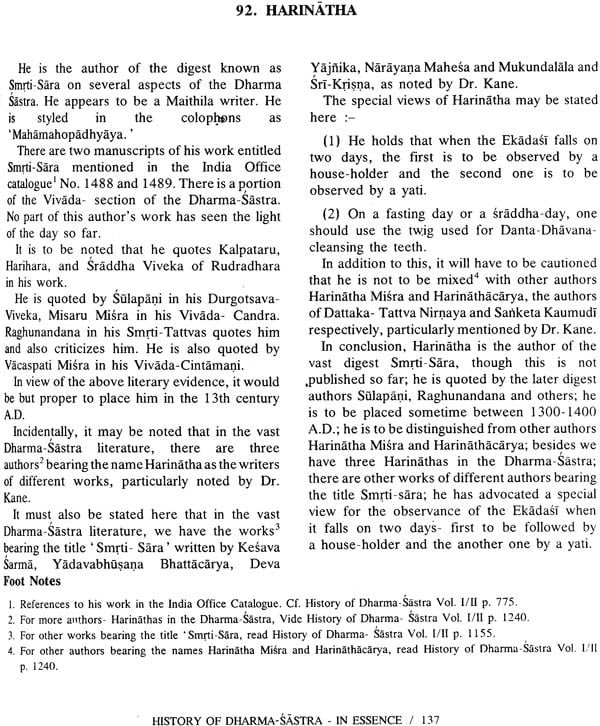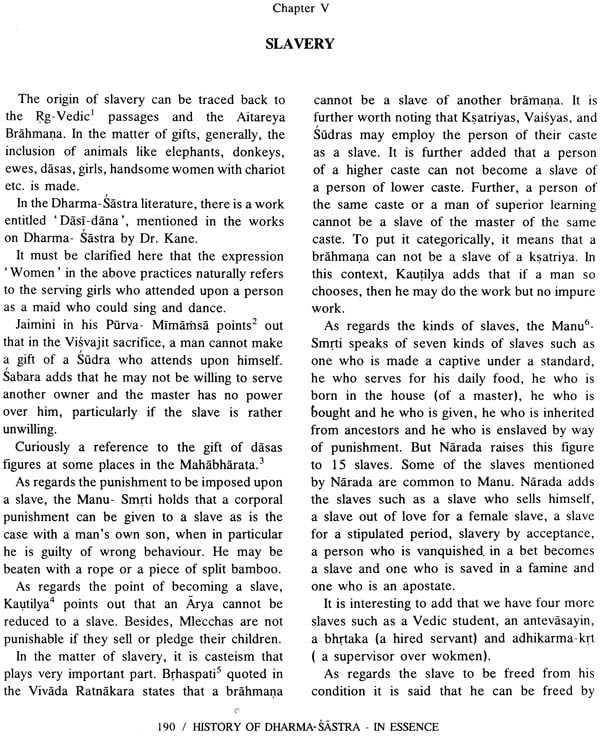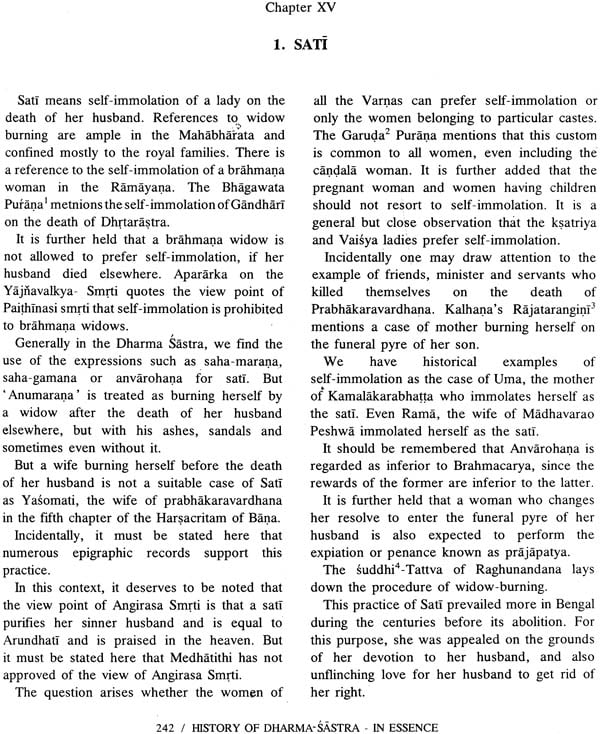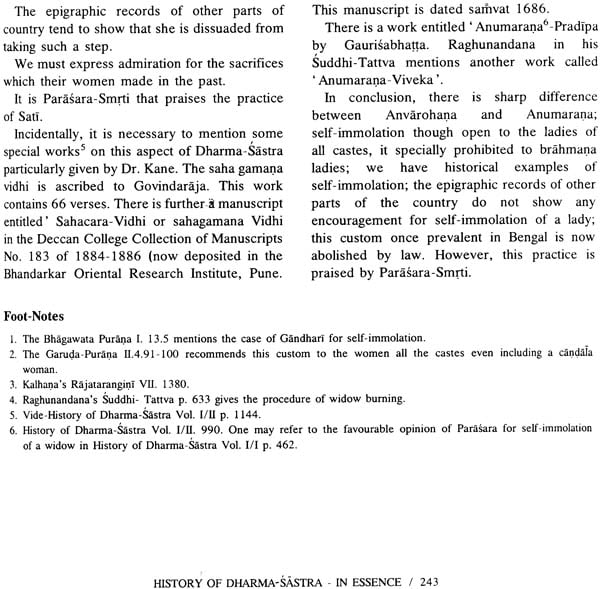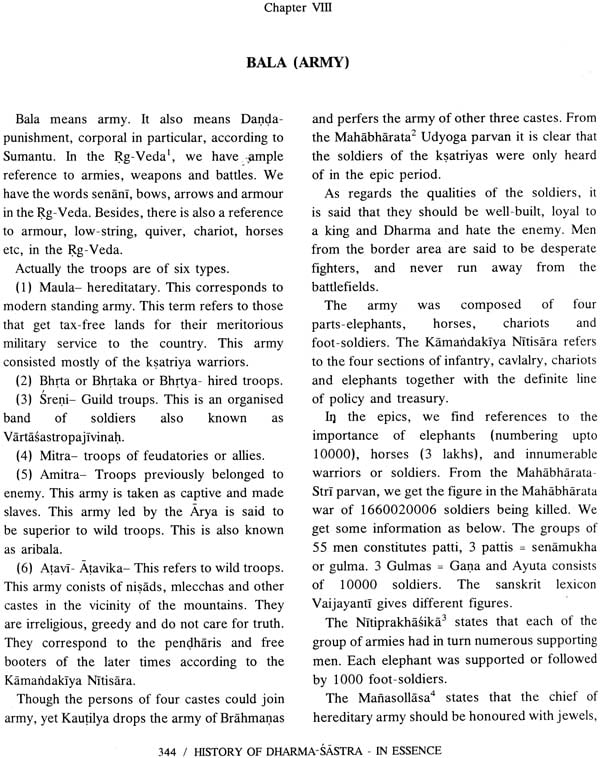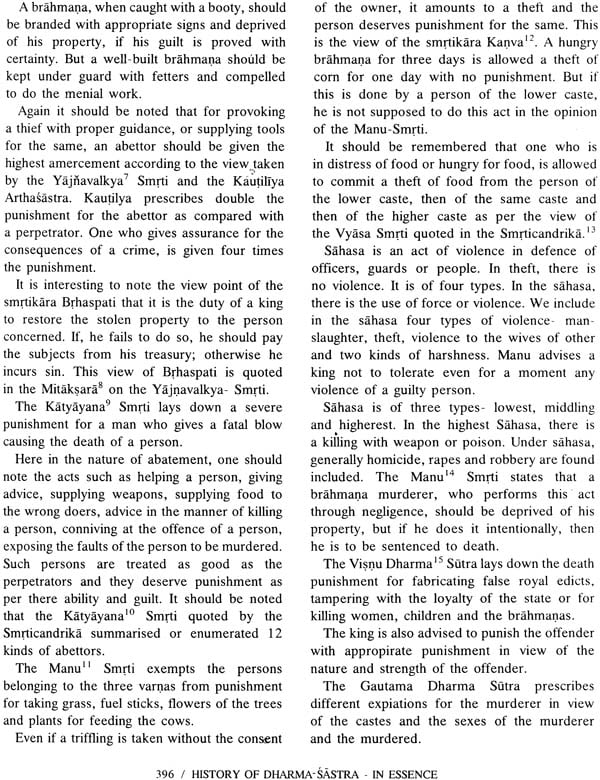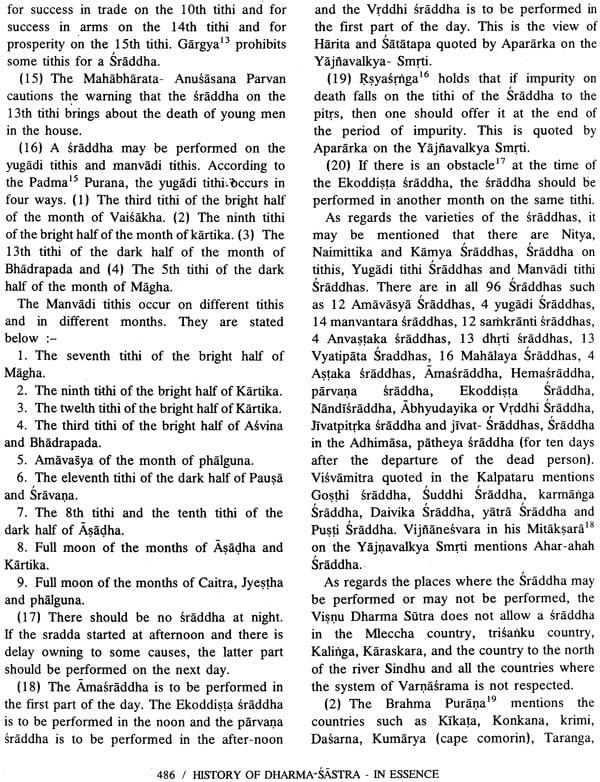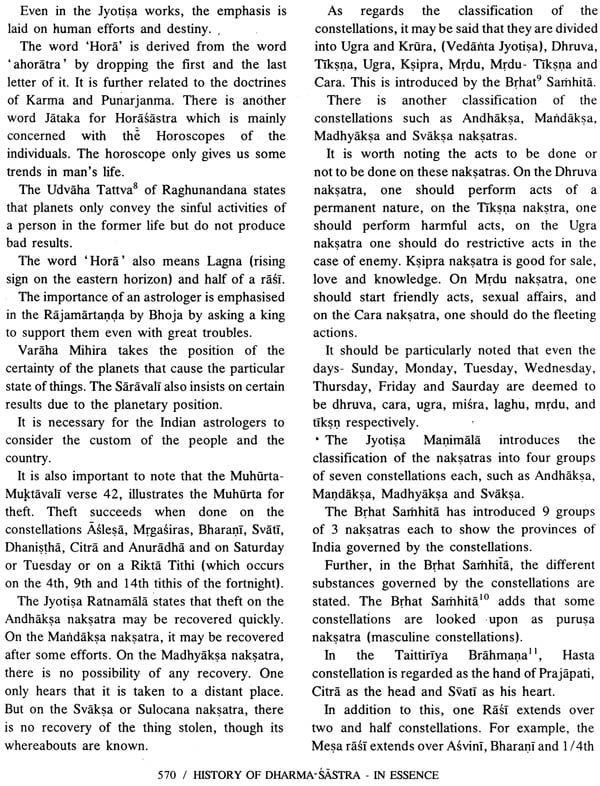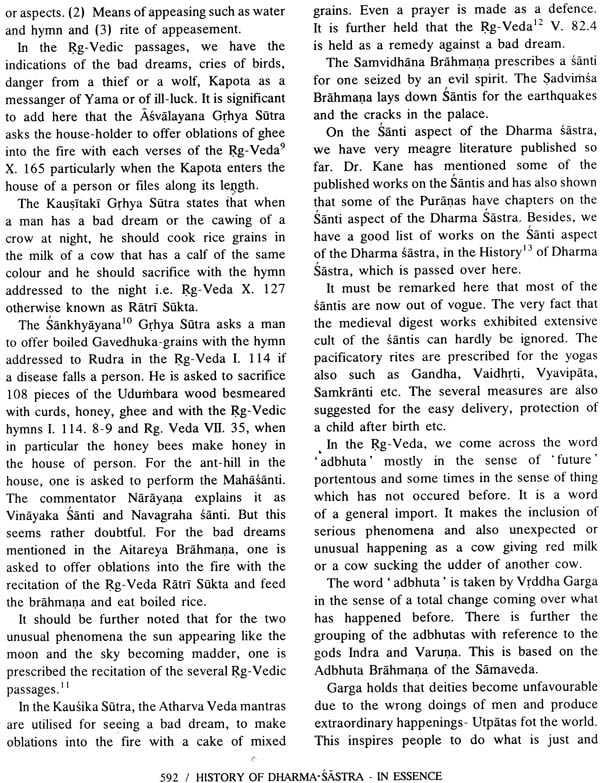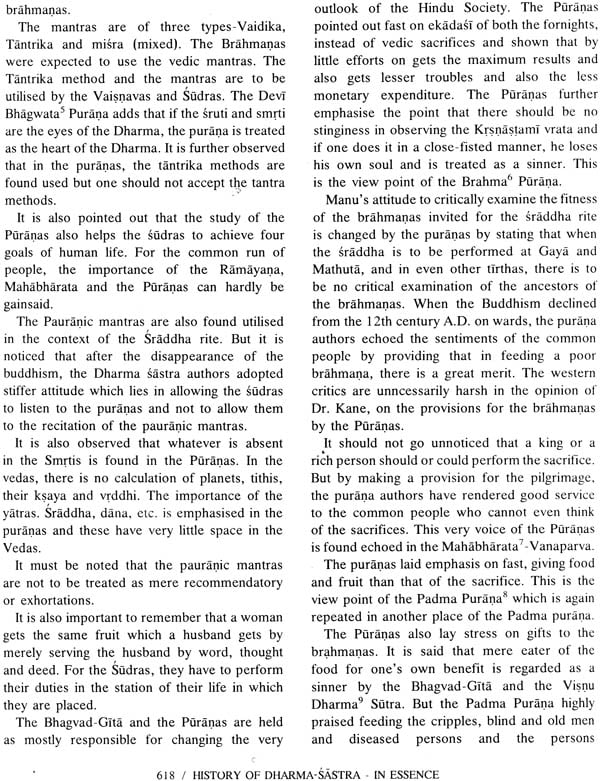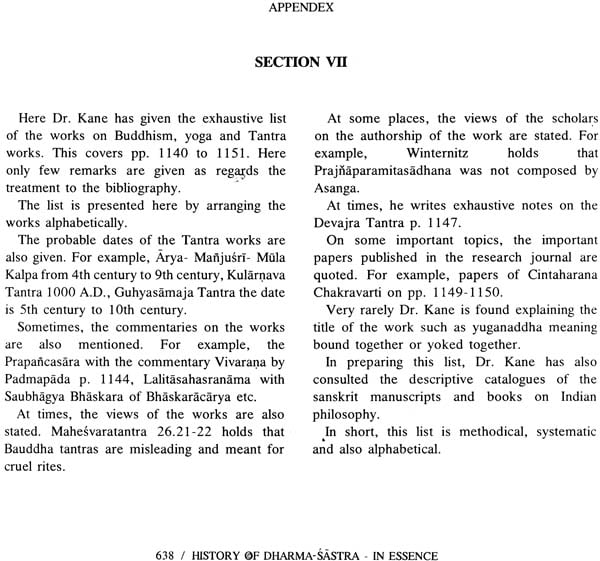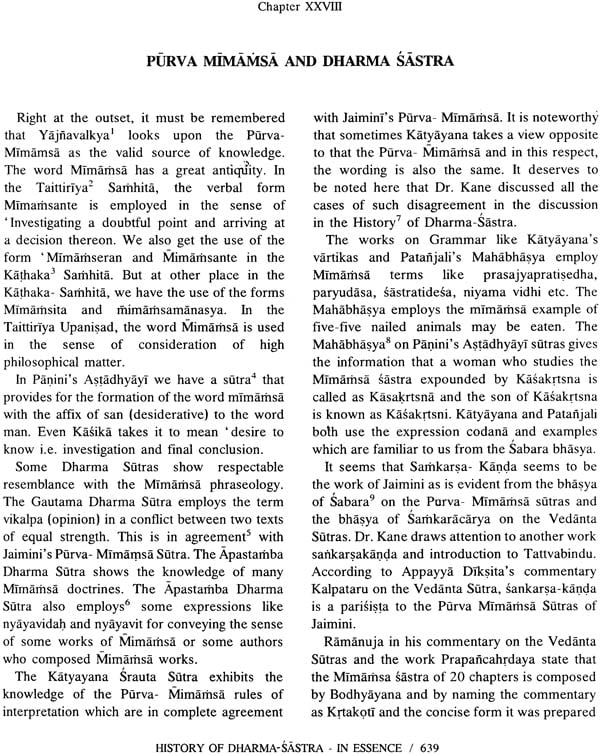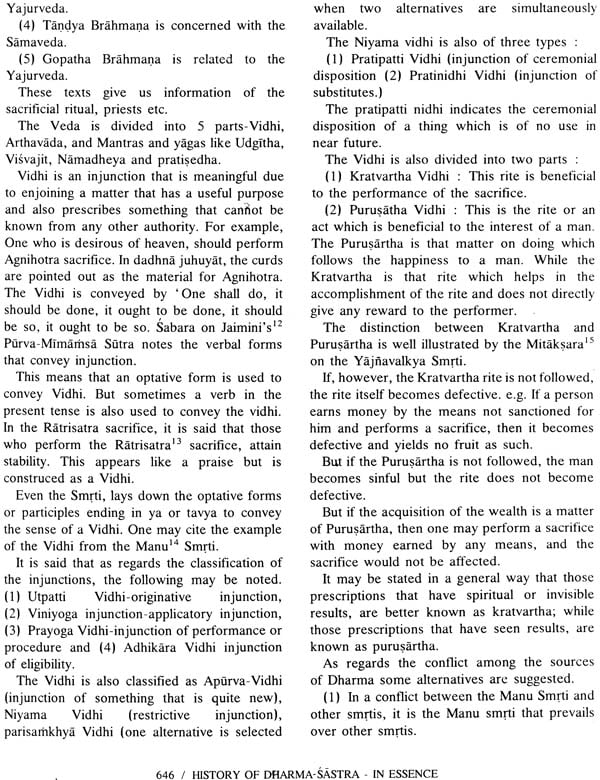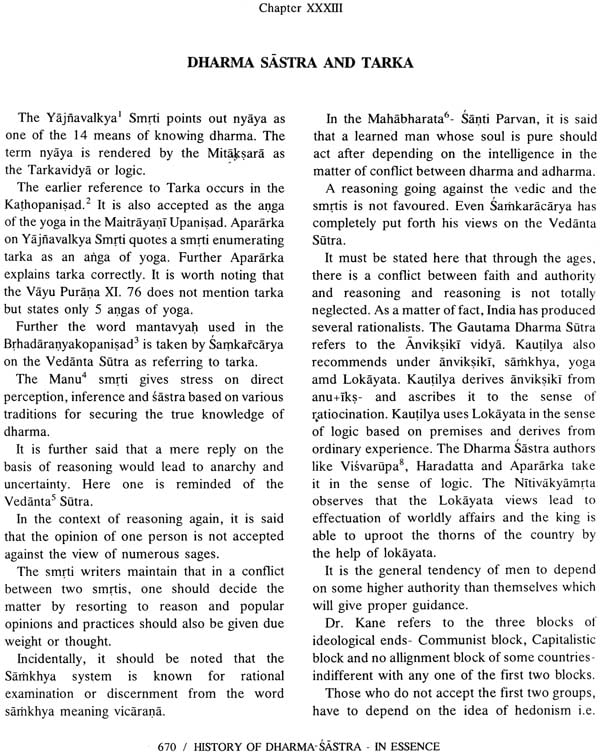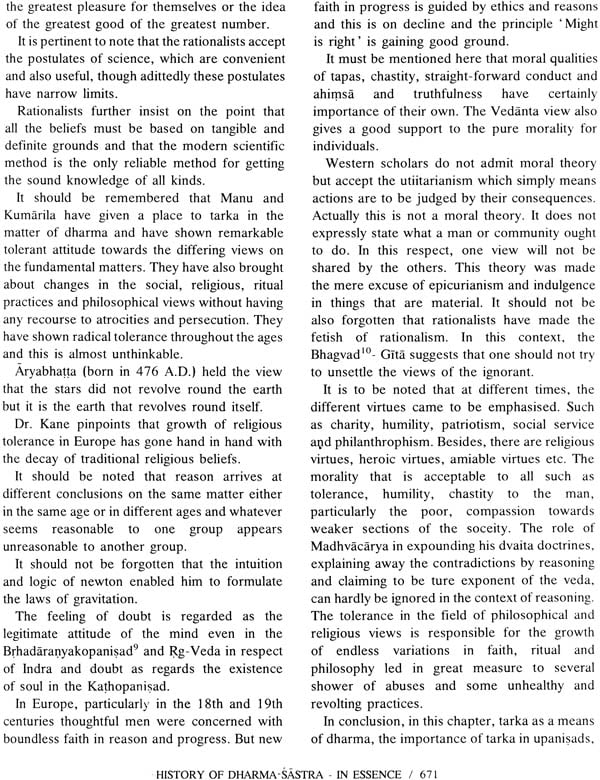
History of Dharmasastra in Essence
Book Specification
| Item Code: | NAK053 |
| Author: | Dr. S. G. Moghe |
| Publisher: | Bhandarkar Oriental Research Institute, Pune |
| Language: | English |
| Edition: | 2000 |
| ISBN: | 9788194145400 |
| Pages: | 718 |
| Cover: | Hardcover |
| Other Details | 11.5 inch x 9.0 inch |
| Weight | 1.80 kg |
Book Description
The encyclopaedic history of Dharmasastra represents a monumental single – handed effort by the Bharataratna Dr. Pandurang Vaman Kane (07.05.1880-18.04.1972). The original work in seven volumes covering more than six thousand five hundred pages and the first volume revised in mid-sixties contain such extensive discussion of smrtis, Sanskrit literature, numismatics, epigraphy and lexicography that these volumes are used mainly by scholars for purposes of reference. A strong feeling was expressed by several persons that the contents of this great work should be made accessible in a concise form to non-specialist general readers in India as well as in other English speaking countries. This has now been done by Dr. S. G. Moghe, a dedicated scholar in the field of history of Dharmsastra.
Several special or novel features of the present book are worth mentioning. The work of Dr. P. V. Kane in the field of Dharmasastra was published over a long period of four fecades. So discussions of particular topics by Dr. Kane are to be found not only in different volumes of the History of Dharmasastra but also in other books and journals. In the present book, an attempt has been made to present coherent accounts of these discussions. Summaries of chapters and long sections in the original work are also given for the benefit of the intended readers. Further, only judiciously selected important references are included in order not to burden the lay reader with unnecessary details.
The message of the History of Dharmasastra is expected to spread to a large national and international readership by the availability of this condensed version retaining the essence of the original work.
In presenting this volume entitled 'Mahamahopadhyaya Dr. P. V. Kane's History of Dharma. Sastra – in essence to the scholarly world, my joy knows no bounds for the simple reason that by this work my name has now become inseparably connected with that towering personality and doyen of Sanskrit scholars in the domain of research and particularly the Dharma Sastra research.
It must be stated here right at the very outset, that this edition is prepared, keeping in mind, the interest of the common public and general readers of the dharma-sastra literature and incidentally to serve the needs of the scholars-both occidental and oriental.
In giving the essence of all the volumes of all the History of Dharma-Sastra, I have framed and followed some principles, which may be briefly stated here.
1. The ritual procedures are preferably dropped.
2. The Devanagari quotations are mostly curtailed.
3. The long discussions involving the views of the prime facie and the siddhanta are dropped and only the conclusions drawn by Dr. Kane are stated.
4. The matter that is available in other articles of Dr. Kane but having no place in the volumes of the Dharma Sastra is either utilised, or referred to, as per the space at my disposal.
5. In dealing with the authors of Dharma Sastra in the first two volumes, attention is focussed on the personal history (if available), their dates and their special views and the identification if any. Besides, in the case of these authors or the Smrtikaras, their views scattered in other volumes are also brought together. The same is the case with the other topics that are discussed in the other volumes.
6. The less scope is given for the criticism of the views of scholars at the hands of Dr. Kane unless such discussion become unavoidable in the context.
7. The number of authorities for any view are stated by curtailing the number.
8. The quotations for any view are generally given in the foot-notes and it is very rarely that the references are given in the body of the chapter.
9. At the end of every chapter, the conclusions are briefly stated for the interest of the General readers.
10. Dr. Kane's method of seeking corroboration for any view in the light of the evidence from history, epigraphy, classical Sanskrit literature, grammar and unpublished manuscripts and the position of such views in the modern Hindu case Law, is fully utilised here.
11. At some places, however, the attention of the readers is also drawn to the lengthy discussion in the volumes of the History of Dharma Sastra for additional details, only to achieve brevity.
12. In the case of the Smrtikaras and the digest authors in particular. The readers will find adequate references to such publications and also the reviews on the same, by admitting my own limitations and also my dependence on the reputed journal of the Bhandarkar Oriental Research Institute, Pune, and other journals in which either.
13. At some places, however, after the completion of the foot-not, I have added some special foot – notes to explain the difficult point to the general readers or drawn the attention of the readers to the particular page of the volume of the history of Dharma Sastra.
14. As regards some lengthy lists in the volumes, I have given introductory and useful remarks showing the method of the treatment of Dr. Kane. The same is the case with the Appendixes gives by Dr, Kane.
15. The judicious use of the Appendix of Dharma Sastra works and authors at the end of the History of Dharma Sastra Vol. I/II, will have to be regarded as the novel feature of this work. In addition to this, I have also utilised another book 'professor Kane's contribution to the Dharma Sastra Literature' particularly edited by me, by publishing 19 valuable papers in the year
| Preface | 2 | |
| Chronological Table | 5 | |
| List of works consulted | 8 | |
| Dharma – sastra Vol.I/I | ||
| 1 | Meaning of Dharma | 1 |
| 2 | Sources of Dharma | 3 |
| 3 | When Dharma – Sastra works were first composed | 4 |
| 4 | The Dharma sutras | 6 |
| 5 | The Dharma Sutra of Gautama | 7 |
| 6 | The Baudhayana Dharma Sutra | 9 |
| 7 | The Dharma Sutra of Apastamba | 11 |
| 8 | The Hiranyakesi Dharma Sutra | 13 |
| 9 | The Vasistha Dharama Sutra | 14 |
| 10 | The Visnu Dhara Sutra | 16 |
| 11 | The Dharma Sutra of Harita | 18 |
| 12 | The Dharma Sutra of Sankha – Lakhita | 20 |
| 13 | Manava – Dharma Sutra Did it exist? | 22 |
| 14 | The Arthasastra of Kautilya | 24 |
| 15 | Vaikhanasa Dharma Sutra | 28 |
| 16 | Atri | 29 |
| 17 | Usanas | 30 |
| 18 | Kanva and Kanya | 32 |
| 19 | Kasyapa and Kasyapa | 33 |
| 20 | Gargya | 34 |
| 21 | Cyavana | 35 |
| 22 | Jatukarnaya | 36 |
| 23 | Devala | 38 |
| 24 | Paithinasi | 40 |
| 25 | Budha | 42 |
| 26 | Brhaspati | 43 |
| 27 | Bharadvaja and Bharadvaja | 44 |
| 28 | Satatapa | 45 |
| 29 | Sumantu | 46 |
| 30 | The Smrtis | 47 |
| 31 | The Manu Smrti | 49 |
| 32 | The two epics | 52 |
| 33 | The Puranas | 56 |
| 34 | The Yajnavalkyas Smrti | 57 |
| 35 | The Parasara Smrti | 60 |
| 36 | The Narada Smrti | 62 |
| 37 | The Brhasapati Smrti | 64 |
| 38 | Katyayana | 66 |
| 39 | The Angirasa Smrti | 68 |
| 40 | Rsysrnga | 69 |
| 41 | Karsnajini | 70 |
| 42 | Caturvimsati- Mata | 71 |
| 43 | Daksa | 72 |
| 44 | Pitamaha | 73 |
| 45 | Pulastya | 75 |
| 46 | Paithinasi | 76 |
| 47 | Pracetas | 77 |
| 48 | Prajapati | 78 |
| 49 | Marici | 79 |
| 50 | Yama | 81 |
| 51 | Laugaksi | 82 |
| 52 | Visvamitra | 83 |
| 53 | Vyasa | 84 |
| 54 | Sat Trimsat Mata | 86 |
| 55 | Sangraha or Smrtisangraha | 87 |
| 56 | Samvarta | 88 |
| 57 | Harita | 89 |
| 58 | Commentaries and Nibandhas | 90 |
| 59 | Asahaya | 91 |
| 60 | Bhartryajna | 92 |
| 61 | Visvarupa | 93 |
| 62 | Bharuci | 95 |
| 63 | Srikara | 96 |
| 64 | Medhatithi | 98 |
| Dharma Sastra Vol. I/II | ||
| 65 | Dharesvara Bhojadeva | 99 |
| 66 | Devasvamin | 101 |
| 67 | Jitendriya | 102 |
| 68 | Balaka | 103 |
| 69 | Balorupa | 104 |
| 70 | Yogloka | 105 |
| 71 | Vijnanesvara | 106 |
| 72 | Kamadhenu | 108 |
| 73 | Halayudha | 109 |
| 74 | Bhavadeva bhatta | 111 |
| 75 | Prakasa | 113 |
| 76 | Parijata | 114 |
| 77 | Govindaraja | 115 |
| 78 | The kalpataru of Laksmidhara | 116 |
| 79 | Jimutavahana | 118 |
| 80 | Apararka | 120 |
| 81 | Pradipa | 121 |
| 82 | Smrtyarthasara of Sridhara | 122 |
| 83 | Aniruddha | 124 |
| 84 | Ballalasena and Laksmanasena | 125 |
| 85 | Harihara | 127 |
| 86 | The Smrticandrika of Devannabhatta | 128 |
| 87 | Haradatta | 129 |
| 88 | Hemadri | 131 |
| 89 | Kullukabhatta | 133 |
| 90 | Sri Datta Upadhyaya | 134 |
| 91 | Candesvara | 136 |
| 92 | Harinatha | 137 |
| 93 | Madhavacarya | 138 |
| 94 | Madanapala and Visvesvarabhatta | 140 |
| 95 | Madanaratna | 142 |
| 96 | Vidyapati | 144 |
| 97 | The Vyavahara Nirnaya of Varadaraja | 145 |
| 98 | Sulapani | 146 |
| 99 | Rudradhara | 148 |
| 100 | Misaru Misra | 149 |
| 101 | Vacaspati Misra | 150 |
| 102 | The Dandaviveks of Vardhamana Upadhyaya | 151 |
| 103 | Nrsimha Prasada | 152 |
| 104 | Prataparudradeva | 153 |
| 105 | Dharma Tattva Kalanidhi or Prthavicandrodaya. | 154 |
| 106 | Govindananda | 155 |
| 107 | Raghunandana | 156 |
| 108 | Narayanabhatta | 158 |
| 109 | Todarananda | 159 |
| 110 | Nandapandita | 160 |
| 111 | Kamalakarabhatta | 161 |
| 112 | Nilakanthabhatta | 162 |
| 113 | Viramitrodaya | 164 |
| 114 | Anantadeva | 165 |
| 115 | Nagojibhatta | 166 |
| 116 | Balakrsna or Balambhatta | 167 |
| 117 | Kasinatha Upadhyaya | 168 |
| 118 | jagannathaTarkapancanana | 169 |
| 119 | brief note on the works and writers from kamarupa | 170 |
| 120 | appendix 'A' | 171 |
| Dharma Sastra Vol. II/I | ||
| 1 | The topics of Dharma Sastra | 172 |
| 2 | Varna | 175 |
| 3 | The duties and disabilities and privileges of the Varnas | 181 |
| 4 | Untouchability | 188 |
| 5 | Slavery | 190 |
| 6 | Samskaras | 193 |
| 7 | Upanayana | 199 |
| 8 | The Asramas | 212 |
| 9 | Marriage | 215 |
| 10 | Madhuparka | 228 |
| 11 | Polyandray, Polygamy, and rites and duties on Marriage | 230 |
| 12 | The duties of a widow, some privileges of women and the parda system | 233 |
| 13 | Niyoga | 237 |
| 14 | Remarriage of widows | 239 |
| 15 | Sati | 242 |
| 16 | Vesya | 244 |
| 17 | Ahinka and Acara | 246 |
| 18 | Panca Mahayajnas | 252 |
| Dharma Sastra Vol. II/II | ||
| 19 | Devayajna | 254 |
| 20 | Vaisvadeva | 258 |
| 21 | Nryajna or Manusya Yajna | 260 |
| 22 | Bhojana | 262 |
| 23 | Upakarma and Utsarjana | 269 |
| 24 | Minor Grhya and other rites | 271 |
| 25 | Dana | 274 |
| 26 | Pratistha and Utsarga | 280 |
| 27 | Vanaprastha | 284 |
| 28 | Samnyasa | 287 |
| 29 | Srauta sacrifices | 191 |
| 30 | The Darsapurnamasa | 294 |
| 31 | Caturmasyas | 298 |
| 32 | Pasubandha | 302 |
| 33 | Agnistoma | 304 |
| 34 | Other Soma sacrifices | 308 |
| 35 | Sautramani and Other sacrifices | 312 |
| 36 | A note on appendix and general index | 314 |
| Dharma Sastra Vol. III | ||
| 1 | Rajadharma | 318 |
| 2 | Seven Anges of Rajya | 320 |
| 3 | Duties and Responsibilies of the Ruler | 325 |
| 4 | Ministers | 330 |
| 5 | Rastra | 333 |
| 6 | Durga | 339 |
| 7 | Kosa | 341 |
| 8 | Bala | 344 |
| 9 | Suhrd or Mitra | 348 |
| 10 | Purpose of the study of Rajadharma | 351 |
| 11 | Vayavahara (Law and Administration of justice) | 353 |
| 12 | Bhukti (possession) | 360 |
| 13 | Witnesses | 362 |
| 14 | Divyas (ordeals) | 367 |
| 15 | Decision | 370 |
| 16 | Contracts, Debts, Pledges and Morthages | 375 |
| 17 | Asvamikraya | 379 |
| 18 | Sambhuya Sambhya Samuttha | 381 |
| 19 | Dattanapakarma | 383 |
| 20 | Vetanasya anapakarma | 385 |
| 21 | Samvid Vyatikrama and other titles | 387 |
| 22 | Sima Vivada | 391 |
| 23 | Abuse, Defamation and Assault | 393 |
| 24 | Steya | 395 |
| 25 | Stri – Sangrahana | 399 |
| 26 | Dyuta Samavhaya (Gambling and prize fighting) | 402 |
| 27 | Dayadhaga | 404 |
| 28 | Adoption | 411 |
| 29 | Order of Succession after son | 416 |
| 30 | Stridhana | 422 |
| 31 | Maintenance and other topics | 426 |
| 32 | Sadacara – Customs and modern Customary law | 429 |
| 33 | Culstoms and dharma Sastra works | 433 |
| 34 | Kalivarjyam (Actions forbidden in the Kali) | 437 |
| 35 | Customs in Modern Indian Law | 440 |
| 36 | A note on the Appendix | 442 |
| Dharma Sastra Vol. IV | ||
| 1 | Sin | 444 |
| 2 | Means of reducing the consequences of the sin | 449 |
| 3 | Prayascitta-Its orgin, derivation and (meaning) | 453 |
| 4 | Expiations for particular sins | 458 |
| 5 | Names of all the Prayascittas | 464 |
| 6 | Consequence of not undergoing penances | 467 |
| 7 | Eschatology | 471 |
| 8 | Suddhi | 479 |
| 9 | Sraddha | 484 |
| 10 | Ekoddista and other sraddhas | 494 |
| 11 | Tirthayatra | 501 |
| 12 | The ganges | 504 |
| 13 | Kasi | 507 |
| 14 | Gaya | 511 |
| 15 | Kuruksetra and some other famous tirthas | 514 |
| 16 | List of Tirthas A Note | 52 |
| Dharma Sastra Vol. V/I | ||
| 1 | Vrata in the Rg – Veda | 524 |
| 2 | Vratas in Vedic literature, Sutras and Smrtis | 527 |
| 3 | Vratas, objects, classification and times for vratas | 531 |
| 4 | Individual Vrats – Caitra Pratipada, Rama – Navami, Aksyya Trtiya, Parasurama jayanti Dasahara and Savitri Vrata | 534 |
| 5 | Ekadasi | 537 |
| 6 | Caturmasya | 541 |
| 7 | Vratas called Naga Pancami, Manasa puja, Raksa bandhana and Krsna Janmastami | 542 |
| 8 | Vratas of Haratalika, ganesa Caturthi Rsi Pancami and Anant Caturdas | 545 |
| 9 | Navaratra or Durgotsava | 548 |
| 10 | Vijaya Dasami and Diwali | 551 |
| 11 | Mahasamkranti and Mahasivaratri | 553 |
| 12 | Holika and Grahana | 556 |
| 13 | List of Vratas A note | 559 |
| 14 | Conception of Kala | 561 |
| 15 | Units of Time | 564 |
| 16 | Muhurta | 569 |
| 17 | Muhurtas for Religious Rites | 576 |
| 18 | Calender, Eras, various reckonings about years Months etc. | 580 |
| 19 | Kalpa, Manvantara. Mahayuga and Yuga | 586 |
| Dharma Sastra Vol. V/II | ||
| 20 | Vedic meaning and procedure of Santis | 591 |
| 21 | Individual Santis | 595 |
| 22 | Origin and development of Purana Literature | 601 |
| 23 | Brief notes on Individual Puranas and Upa Puranas | 608 |
| 24 | Influence of the Puranas on Dharma Sastra | 617 |
| 25 | Causes of the disappearance of Buddhism from India | 623 |
| 26 | Tantrika Doctrines and Dharma Sastra | 626 |
| 27 | Nyasa, Mudras, Tantra, Cakra, Mandala and Appendix of works on Tantra A note | 634 |
| 28 | Purva Mimamsa and Dharma Sastra | 639 |
| 29 | Some fundamental doctrines of Purva Mimamsa | 644 |
| 30 | Mimamsa Rules of Interpretation in Relation to Dharma Sastra | 649 |
| 31 | Dharma Sastra and Samkhya | 657 |
| 32 | Dharma Sastra and yoga | 662 |
| 33 | Dharma Sastra and Tarka | 670 |
| 34 | Cosmology | 673 |
| 35 | Fundamental and Leading Characteristics of Hindu Culture and Civilization | 78 |
| 36 | The Doctrine of Karma and Punarjanma. (Transmigration or Metempsychosis) | 682 |
| 37 | Future Trends | 689 |
